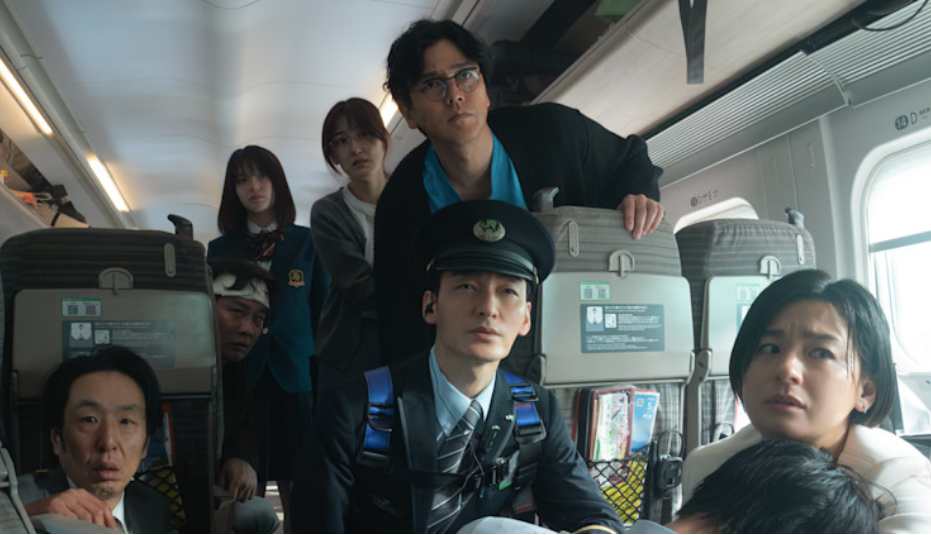Netflix Japan’s newest action-packed movie, BULLET TRAIN EXPLOSION, isn’t just another disaster movie; it’s a work of art based on real events. In this remake of the 1975 classic “Bullet Train,” a time bomb is set off on one of Japan’s fastest and most advanced trains. The tension is high, and the realism is jaw-dropping. But the real star of the show? The location itself: Japan’s legendary Shinkansen, filmed with unprecedented access that makes this action thriller pulse with realism.
As the camera speeds down the tracks at over 100 km/h, one question echoes louder than the explosions—where was this cinematic rollercoaster filmed? The answer is as thrilling as the story it tells.
BULLET TRAIN EXPLOSION PLOT
BULLET TRAIN EXPLOSION, directed by Shinji Higuchi (renowned for Shin Godzilla), thrusts viewers into a high-stakes scenario: a bomb has been planted aboard the Hayabusa No. 60, a sleek Shinkansen bullet train traveling from Tokyo. If the train slows below 100 km/h, the bomb will detonate—killing everyone on board.
Tsuyoshi Kusanagi stars as the brave conductor Takaichi, who alongside his colleague Fujii (played by Kanata Hosoda) and the skilled driver Matsumoto (portrayed by Non), must keep the train racing forward while grappling with the chaos erupting onboard. Machiko Ono brings political gravity as Diet member Kagami, while Jun Kaname adds flair as the entrepreneur and YouTuber Todoroki. Takumi Saitoh plays Kasagi, the General Commander coordinating efforts from the Shinkansen General Operation Control Center. Meanwhile, Hana Toyoshima gives a grounded performance as Yuzuki, a high schooler caught in the middle of a nightmare.
The film is as much a character-driven drama as it is a race against time. But underneath all the action and urgency lies the beating heart of the film—its locations.
A FIRST IN JAPANESE CINEMA HISTORY: THE REAL BULLET TRAIN

For BULLET TRAIN EXPLOSION, Netflix Japan went where few productions have gone before—inside an actual bullet train, while in motion.
Speaking during the Netflix Asia-Pacific showcase in Tokyo, Shinichi Takahashi, Netflix Japan’s Director of Live Action Content, revealed a behind-the-scenes achievement: “We were able to rent an entire bullet train and film it in motion seven times, traveling back and forth from Tokyo to Aomori.”
This was not mere second-unit footage or green-screen magic. The cast and crew filmed real scenes on real tracks, capturing the natural motion and dynamic tension of a high-speed train in operation. With the help of the East Japan Railway Company (JR East), the filmmakers were able to get inside Shinkansen stations, depots, control rooms, and see how the system works. The first movie, which came out in 1975, didn’t have that level of realism, mostly because of safety concerns.
To secure this collaboration, Netflix initiated extensive pre-production planning with JR East, negotiating logistics and safety protocols. It was a historic step forward for Japanese filmmaking and a major win for Netflix’s global content ambitions.
During the Netflix APAC showcase, Shinichi Takahashi talked about how big the production was and how they worked together with JR East. “We were able to rent a whole bullet train and film it moving seven times, going back and forth from Tokyo to Aomori,” he said, adding that this made the movie seem more real. He also spoke about the construction of the full-sized train cars and the 1/6 scale model, explaining, “Our primary focus was on ensuring the audience could feel the authenticity and realism of the bullet train.” These efforts, he said, were crucial to immersing viewers in the story’s high-stakes world.
While filming aboard a real bullet train added authenticity, the production didn’t stop there. The team built two full-scale bullet train cars using authentic materials, down to the upholstery and signage. Interior scenes—where much of the character drama unfolds—were filmed inside these meticulously recreated cars.
“The goal was to make the audience feel they were truly on the Shinkansen,” Takahashi explained.
For the climactic explosion sequences, the special effects team went bigger than usual—constructing a 1/6 scale model of the train. Most miniatures used in cinema are 1/20 scale, but this larger model offered more visual impact and dynamic realism, especially when capturing scenes involving destruction and derailment. Cameras had to match the speed of the miniature as it hurtled down the custom-built track. The result? Stunning visuals that still feel grounded.
Additionally, the production used the ALFA-X, an experimental Shinkansen prototype used for high-speed testing on the Tohoku line. By incorporating a cutting-edge real-world train into the film, the movie not only ramped up the visual intensity but subtly commented on Japan’s technological innovation.
Director Shinji Higuchi, a master of tokusatsu (practical effects), praised the collaboration with Netflix: “In the past, I would have known that it would be rejected at the planning stage… With Netflix this time, we were able to do everything we have always wanted to do for many years.”
Poster artist Lambert, who illustrated the movie’s key visuals, echoed the enthusiasm. “It is a great honor to be asked by Netflix to illustrate a poster for such a big and exciting new movie. I had the opportunity to create a dramatic poster that captures the intensity of the movie with high-speed action and excellent performances from the cast.”
For the cast, the experience was no less exhilarating. Real trains were used for filming, which added a physical sense of tension and movement that let the actors really get into their roles. Especially Kusanagi talked about how the Shinkansen’s small space forced him to feel things in new ways.
TOKYO TO AOMORI: THE ROUTE OF THRILLS
View this post on Instagram
All principal photography took place in Tokyo, Japan, with the team using the actual train route from Tokyo to Aomori for many in-motion scenes. This decision wasn’t just about spectacle—it allowed the film to incorporate real geographical transitions and landscapes, adding depth to the narrative journey. Japan’s natural beauty flashing by through the windows contrasts sharply with the life-or-death stakes inside the train.
Even the control center scenes were filmed in actual railway facilities, providing a rare look into Japan’s famously efficient rail operations. These realistic backdrops are what make BULLET TRAIN EXPLOSION feel not just urgent, but authentic.
A NEW ERA FOR JAPANESE CINEMA
BULLET TRAIN EXPLOSION is more than a thrilling action flick—it’s a sign of how far Japanese filmmaking has come in terms of global collaboration and technical ambition. With Netflix backing daring projects like this one, local creators are being empowered to tell bold, globally relevant stories without compromising authenticity.
And the real hero of this story—the Shinkansen—proves once again that it’s not just a marvel of transportation, but also a star of the screen.
For those curious about where reality ends and fiction begins in BULLET TRAIN EXPLOSION, know this: the tension may be scripted, but the trains, the routes, the sweat, and the speed? All real.
Keep your eyes on the track—Netflix’s ride has only just begun.
Stay tuned to tvacute.com for more exclusive updates, behind-the-scenes stories, and deep dives into your favorite Netflix thrillers like BULLET TRAIN EXPLOSION.
IS BULLET TRAIN EXPLOSION ON NETFLIX INSPIRED BY TRUE EVENTS?







